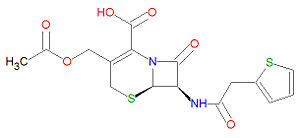Cefalotin: Difference between revisions
Jump to navigation
Jump to search

imported>David E. Volk m (→External links) |
imported>David E. Volk mNo edit summary |
||
| Line 18: | Line 18: | ||
'''Cefalotin''', also called '''sefalothin''', is a semisynthetic first generation [[cephalosporin]] [[antibiotic]] compound that is structurally similar to other cephalosporins including [[cefaclor]], [[cefadroxil]] and [[cefazolin]]. | '''Cefalotin''', also called '''sefalothin''', is a semisynthetic first generation [[cephalosporin]] [[antibiotic]] compound that is structurally similar to other cephalosporins including [[cefaclor]], [[cefadroxil]] and [[cefazolin]]. | ||
It is administered [[parenterally]] to prevent infections during surgery or for treating a broad spectrum of infections of the blood, bone or joints, respiratory tract, skin, and urinary tract. | It is administered [[parenterally]] to prevent infections during surgery or for treating a broad spectrum of infections of the blood, bone or joints, respiratory tract, skin, and urinary tract. | ||
Revision as of 15:29, 5 April 2009
|
| |||||||
| cefalotin | |||||||
| |||||||
| Uses: | antibiotic drug | ||||||
| Properties: | beta-lactam | ||||||
| Hazards: | see drug interactions | ||||||
| |||||||
Cefalotin, also called sefalothin, is a semisynthetic first generation cephalosporin antibiotic compound that is structurally similar to other cephalosporins including cefaclor, cefadroxil and cefazolin. It is administered parenterally to prevent infections during surgery or for treating a broad spectrum of infections of the blood, bone or joints, respiratory tract, skin, and urinary tract.
